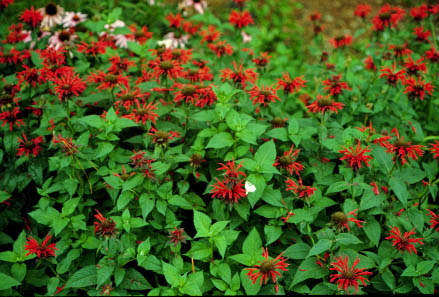
Monarda didyma

Monarda didyma variation, Cambridge scarlet
Courtsey of the UGA Herbarium
Author: Gwen Kathryn Ewald
~~~~~~~~~~~~~~~~~~~~~~~~~~~~~~~~~~~~~~~~~~~~~~~~~~~~~~~~~~~~~~~~~~~~~
|
Common Names: (Bremness, 1988) · Bee balm· Oswego Tea· BergamotHigher Taxa: (Small, 1933) · Class: Magnoliopsida· Order: Lamiales· Family: Lamiaceae (Labiatae)· Tribe: Monardeae· Genus: Monarda· Subgenus: Eumonarda· Species: didyma |
 Drawing of Monarda didyma by Gwen Ewald
|
Identification: This member of the mint family was named by Dr. Nicholas Monardes in his 1569 herbal on American flora. It is suspected that he may have named the plant Bergamot because of the similarity of its scent to the Italian bergamot orange (Bremness, 1988). The name Oswego Tea is attributed to the use of M. didyma leaves for flavoring foods by the Oswego Indians of New York and by patriots boycotting English taxes as a substitute for Chinese teas (Klimas, 1974).
In the Manual of the Southeastern Flora M. didyma is described as follows, "Stem 3-12 dm. tall, sometimes sparingly pubescent: leaf-blades lanceolate or elliptic-lanceolate to ovate, 8-15 cm long, serrate: heads showy: calyx 7-11 mm long; lobes subulate: corolla 35-50 mm long; middle lobe of the lower lip acute."(Small, 1933).
Geography: According to The Audubon Society Field Guide and The Illustrated Book of Wildflowers and Shrubs Monarda didyma is a native species from New York to Michigan south to Georgia, Tennessee and Mississippi (Nierling, 1979; Grimm, 1933). The Manual of the Southeastern Flora states that it is found in "moist woods, stream-banks, thickets, and roadsides, Blue Ridge and more northern provinces, Ga. to Ala., Ont."(Small 1933).
Table 1.North American Distribution of M. didyma
|
Monarda didyma |
|
AREA |
STATUS |
REFERENCES |
|
North America: Continental United States; Canada |
Yes |
|
|
Eastern North America: United States east of Mississippi; Ontario and eastern Canada |
Yes |
|
|
Southeastern United States:AL AR DE FL GA KY MD NC SC TN VA WV |
Yes |
|
|
Southern Appalachian States:AL GA KY MD NC SC TN VA WV |
Yes |
|
|
Coastal Plain |
? |
- |
|
Piedmont |
Yes |
|
|
Blue Ridge Mountains |
Yes |
|
|
Ridge and Valley |
? |
- |
|
Cumberland Plateau |
? |
- |
|
Central Arch |
? |
- |
|
Georgia |
Yes |
|
|
Clarke County, Georgia |
Yes |
Gwen Ewald, Pers. Ob. |
|
Sams Farm |
? |
- |
|
Old field |
unlikely |
Not moist woodland |
|
Wetland |
? |
- |
|
Woods |
possible |
Suitable area |
|
1-Hectare Plot |
? |
- |
General Information: Monarda didyma is a noted asset to landscaping and because it is a hardy perennial it is an excellent plant for novice gardeners(International Herb Association). Bergamot was historically used for a variety of medicinal uses, infused as a tea it can be used to "relieve nausea, flatulence, menstrual pain, and insomnia" and can be helpful in alleviation of sore throats, colds, and bronchial complaints.(Bremness, 1988). The bright scarlet flowers are especially attractive to hummingbirds (Neiring, 1979), butterflies (Grimm, 1933) and bumble bees (Bremness, 1988) as the name Bee balm suggests. It is an aesthetically pleasing plant, the dried flowers retain their color and therefore make an excellent addition to potpourri(Bremness, 1988). The flowers can also be used in salads, The Complete Book of Herbs by Lesley Bremness includes directions for the use of bergamot in a suntan lotion, for tea recipes see the International Herb Association Monarda web site. M. didyma can be found in bloom between June and August in moist areas such as woods and thickets, especially along streams (Nierling, 1979).